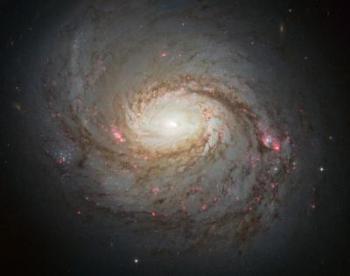Mar 29 2013
Messier 77 is a galaxy in the constellation of Cetus, some 45 million light-years away from us. Also known as NGC 1068, it is one of the most famous and well-studied galaxies. It is a real star among galaxies, with more papers written about it than many other galaxies put together!
 The NASA/ESA Hubble Space Telescope has captured this vivid image of spiral galaxy Messier 77 -- a galaxy in the constellation of Cetus, some 45 million light-years away from us. The streaks of red and blue in the image highlight pockets of star formation along the pinwheeling arms, with dark dust lanes stretching across the galaxy's starry center. The galaxy belongs to a class of galaxies known as Seyfert galaxies, which have highly ionized gas surrounding an intensely active center. Credit: NASA, ESA & A. van der Hoeven
The NASA/ESA Hubble Space Telescope has captured this vivid image of spiral galaxy Messier 77 -- a galaxy in the constellation of Cetus, some 45 million light-years away from us. The streaks of red and blue in the image highlight pockets of star formation along the pinwheeling arms, with dark dust lanes stretching across the galaxy's starry center. The galaxy belongs to a class of galaxies known as Seyfert galaxies, which have highly ionized gas surrounding an intensely active center. Credit: NASA, ESA & A. van der Hoeven
Despite its current fame and striking swirling appearance, the galaxy has been a victim of mistaken identity a couple of times; when it was initially discovered in 1780, the distinction between gas clouds and galaxies was not known, causing finder Pierre Mechain to miss its true nature and label it as a nebula. It was misclassified again when it was subsequently listed in the Messier Catalogue as a star cluster.
Now, however, it is firmly categorised as a barred spiral galaxy, with loosely wound arms and a relatively small central bulge. It is the closest and brightest example of a particular class of galaxies known as Seyfert galaxies -- galaxies that are full of hot, highly ionised gas that glows brightly, emitting intense radiation.
Strong radiation like this is known to come from the heart of Messier 77 -- caused by a very active black hole that is around 15 million times the mass of our Sun. Material is dragged towards this black hole and circles around it, heating up and glowing strongly. This region of a galaxy alone, although comparatively small, can be tens of thousands of times brighter than a typical galaxy.
Although no competition for the intense centre, Messier 77's spiral arms are also very bright regions. Dotted along each arm are knotty red clumps -- a signal that new stars are forming. These baby stars shine strongly, ionising nearby gas which then glows a deep red colour as seen in the image above. The dust lanes stretching across this image appear as a rusty, brown-red colour due to a phenomenon known as reddening; the dust absorbs more blue light than red light, enhancing its apparent redness.
A version of this image won second place in the Hubble's Hidden Treasures Image Processing Competition, entered by contestant Andre van der Hoeven.